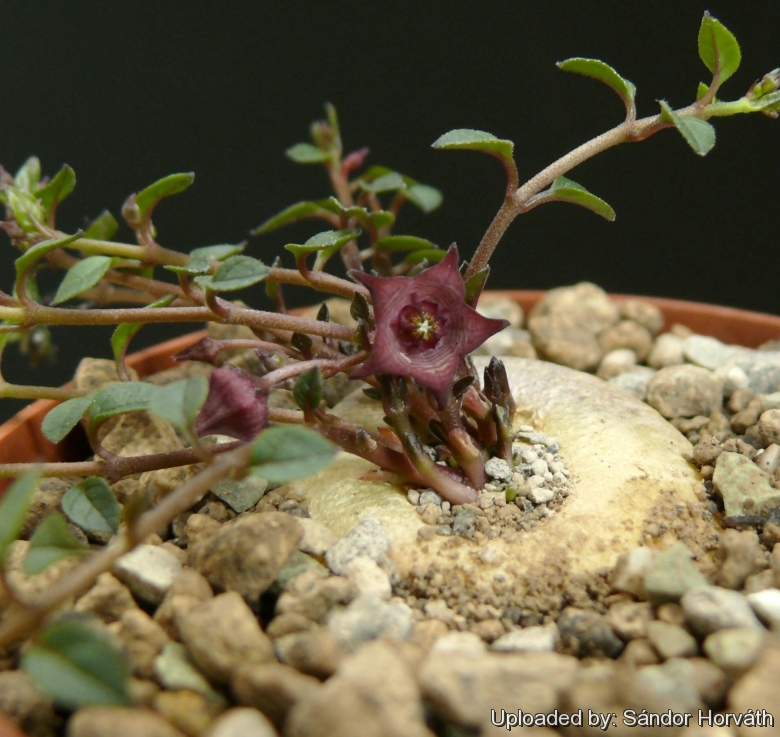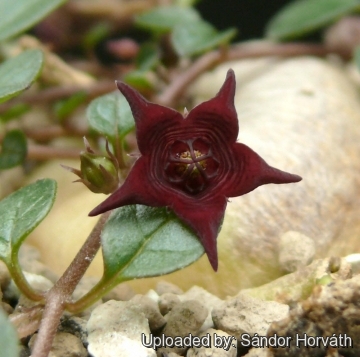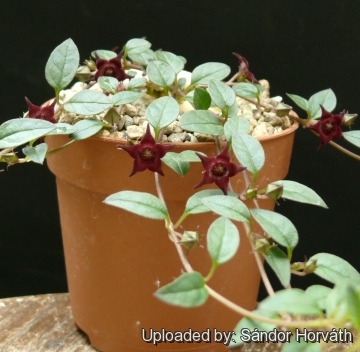




Your support is critical to our success.
Accepted Scientific Name: Brachystelma pulchellum (Harv.) Schltr.
Bot. Jahrb. Syst. 20(5, Beibl. 51): 53. 1895 [28 Jun 1895]

Origin and Habitat: South Africa, KwaZulu-Natal (Range Durban to Pietermaritzburg).Extent of occurrence 400 km². Currently known from 11 locations. It is known to be locally common.
Habitat and Ecology: Savannah. Brachystelma pulchellumSN|32324]]SN|32324]] occur in low grassland, in shallow soils on or near sandstone outcrops or sheets of exposed sandstone, often on the edges of sandstone cliffs. Mostly in low grass, where it is not completely overshadowed and is able to withstand periodic wild fires. Urban development is the most serious threat to this species. In peri-urban areas low-lying grasslands are densely settled and cultivated, but the sandstone plateaux have not been transformed much. However, these plateaux, the highly specific habitat of this species, are used as communal rangelands, and grazed by large herds of cattle. Trampling by cattle is causing the destruction of tubers where they are wedged in shallow soil pockets among rocks. Heavy grazing is however a minor threat in comparison to urban development.
Synonyms:
- Brachystelma pulchellum (Harv.) Schltr.
- Micraster pulchellus Harv.
Description: Brachystelma pulchellumSN|32324]]SN|32324]] is a dwarf perennial geophyte growing from a large flattened discoid tuber (caudex) easily recognized from its creeping growth and the leaves diminishing in size to-wards the stem tips, as well as from the rather small purple, hairless flowers. The corolla is shallowly saucer-shaped. It is unusual in that the linear-lanceolate sepals are conspicuously longer than the united portion of the corolla and protrude well beyond the sinuses as seen from above. Unother of the characteristic features of its truly prostrate habit is the marked reduction in the size of the leaves and length of the internodes towards the end of the flowering period.
Tuber (caudex): 5 cm in diameter, slightly depressed.
Stem: Aerial shoot several, creeping, to 25 cm long, simple or again branching from near base, porrectly hispid with very minute hairs to nearly glabrous.
Leaves: Shortly petiolate (less than 5 mm long), spreading, blade ovate to lanceolate, acute, tapering into the petiole at the base, under cultivation becoming broadly ovate or orbicular, acute or obtuse and apiculate, and rounded to subcordate at the base, thinly puberulous above or glabrous on both sides, 15-20 long, 2-6 mm wide, diminishing in size towards stem tips to 3 x 2 mm, upper face hispid.
Inflorescence: Fowers solitary or in pairs laterally at the nodes, or occasionally in shortly pedunculate 2-flowered umbels. Pedicels 3-7 mm long, thinly puberulous. Sepals 2-4 mm long, lanceolate, acuminate, recurved at the tips, nearly glabrous. Corolla rotate, about 8 - 15 mm in diameter, quite glabrous and not ciliate, dark purple-brown, with transverse dull yellowish lines on the basal part of the lobes. Corolla-tube nearly flat to bowl-shaped, 5 - 6 mm in diameter, inside yellowish, banded with purple. Corolla-lobes free, 2.5 - 4.5 mm long, c 2 mm broad, ovate, acute purple and glabrous. Corona sessile, purple, c. 3 mm in diameter, basally united and shallowly bowl-shaped. Outer corona of 5 small pouches alternating with and below the anthers, dark purple-brown. Inner corona-lobes 0.5 mm long, linear, closely incumbent upon the backs of the anthers and not exceeding them, dark purple-brown. Staminal column 1 mm long. Pollinia D-shaped, c. 0.25 mm long. Style head bulging.
Fruits (follicles): One or two follicles per flower, 3-5 cm long, green.
Bibliography: Major references and further lectures
1) N. E. Brown “Flora of Tropical Africa”, Vol 4, 1904
2) Focke Albers, Ulrich Meve “Illustrated Handbook of Succulent Plants: Asclepiadaceae: Asclepiadaceae”, Volume 4 Springer Science & Business Media, 2002
3) Dyer, R.A. 1978. “Brachystelma pulchellum.” Flowering Plants of Africa 45(1-2):t.1769B.
4) Dyer, R.A. 1980. “Brachystelma, Ceropegia and Riocreuxia.” In: O.A. Leistner (ed). Flora of Southern Africa 27 Part 4:1-88. Botanical Research Institute, Pretoria.
5) Dyer, R.A. 1983. “Ceropegia, Brachystelma and Riocreuxia in southern Africa.” A.A. Balkema, Rotterdam, Netherlands.
6) Scott-Shaw, C.R. 1999. “Rare and threatened plants of KwaZulu-Natal and neighbouring regions.” KwaZulu-Natal Nature Conservation Service, Pietermaritzburg.
7) Wragg, P. 2005. “Brachystelma pulchellum and Durbania amakosa flavida: KZN coastal hinterland endemics.” University of KwaZulu-Natal, Unpublished essay.
8) Wragg, P. 2006. “Conservation status of threatened milkweeds (Apocynaceae) of the Natal Group Sandstone Grasslands: Brachystelma natalense (Schltr.) N.E.Br., B. pulchellum (Harv.) Schltr., and Schizoglossum peglerae N.E. Br.” University of KwaZulu-Natal, Unpublished essay.
9) von Staden, L., Styles, D. & Raimondo, D. 2007. “Brachystelma pulchellum (Harv.) Schltr.” National Assessment: Red List of South African Plants version 2015.1. Accessed on 2016/01/13
10) J.P. Roux “Flora of South Africa”, 2003

Micraster pulchellus (Brachystelma pulchellum) Photo by: Sándor Horváth

Micraster pulchellus (Brachystelma pulchellum) Photo by: Sándor Horváth
Cultivation and Propagation: In cultivation the plants are usually grown in semi shade, with the tubers wholly or (preferably) partially exposed to prevent scorching and rotting of the roots. This plant can take a good deal of water during active growth and should be watered only when not dormant. Keep dryish in winter. It should be overwintered in the greenhouse at temperatures over 12°C (avoid letting temperatures drop lower than 5° C). Use a very draining but rich soil. An error in cultivation may produce unsightly holes in the tuber.
Reproduction: This species can be reproduced by seeds. Sow seeds in summer in a well drained medium.
| Your Actions | |
|---|---|
| Back to Micraster index | |
| Back to Asclepiadaceae index | |
 |
Back to Succulents Encyclopedia index |
Privacy stantement - Terms and conditions - How to cite - About us - Feedback - Donate



